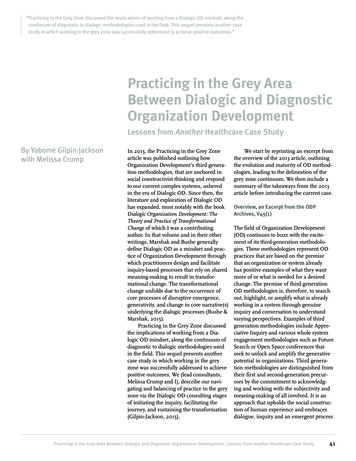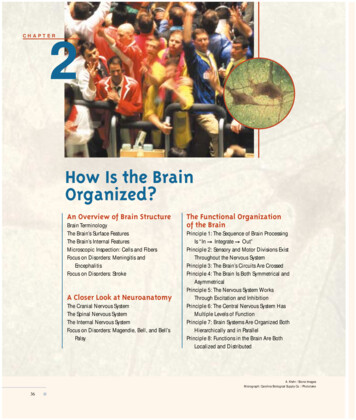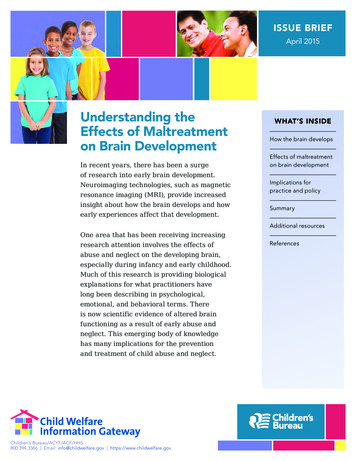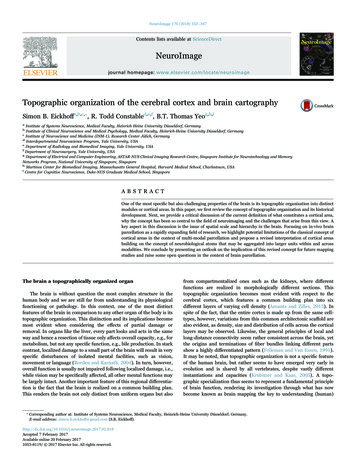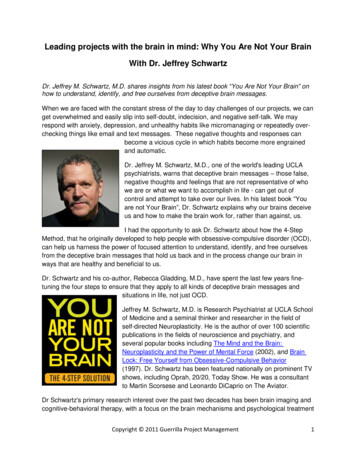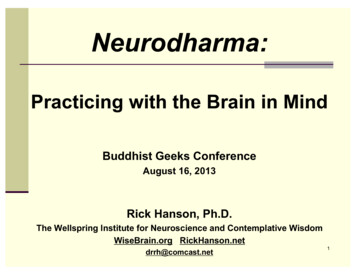
Transcription
Neurodharma:Practicing with the Brain in MindBuddhist Geeks ConferenceAugust 16, 2013Rick Hanson, Ph.D.The Wellspring Institute for Neuroscience and Contemplative WisdomWiseBrain.org RickHanson.netdrrh@comcast.net1
Topics Self-directed neuroplasticity The negativity bias Neurobhavana The fruit and the path2
Self-Directed Neuroplasticity3
The Natural MindApart from the hypothetical influence of atranscendental X factor . . .Awareness and unconsciousness, mindfulnessand delusion, and happiness and sufferingmust be natural processes.Mind is grounded in life.4
Mental activity entailsunderlying neural activity.5
Ardent, Diligent, Resolute, and Mindful6
Repeated mental activity entailsrepeated neural activity.Repeated neural activitybuilds neural structure.7
8
Lazar, et al. 2005.Meditationexperience isassociatedwith increasedcortical thickness.Neuroreport, 16,1893-1897.9
The OpportunityWe can use the mindTo change the brainTo change the mind for the betterTo benefit ourselves and other beings.10
Working with Causes and EffectsMental and physical phenomena arise, persist, andpass away due to causes.Causes in the brain are shaped by the mental/neuralstates that are activated and then installed within it.States become traits.The neural traits of inner “poisons” (e.g., hatred, greed,heartache, delusion) cause suffering and harm.The neural traits of inner strengths (e.g., virtue,mindfulness, wisdom, resilience, compassion, etc.)cause happiness and benefit for oneself and others.11
The Causes of Inner StrengthsHow do we build the neural traits of inner strengths?Inner strengths are mainly built from positiveexperiences.You develop mindfulness by repeatedly being mindful;you develop compassion by repeatedly feelingcompassionate; etc.The brain is like a VCR or DVR, not an iPod: you mustplay the song to record it - you must experience thestrength to install it in your brain.12
A BottleneckFor Growing Inner StrengthsThe problem is that, for survival reasons, the brain ispoor at turning positive states into neural traits.It is bad at learning from good experiences comparedto how good it is at learning from bad experiences.This design feature of the brain creates a kind ofbottleneck that reduces the conversion of positivemental staits to positive neural traits.13
The Negativity Bias14
Evolutionary HistoryThe Triune Brain15
Three Fundamental Motivationaland Self-Regulatory Systems Avoid Harms: Primary need, tends to trump all others Approach Rewards: Elaborated via sub-cortex in mammals foremotional valence, sustained pursuit Attach to Others: Very elaborated via cortex in humans for pairbonding, language, empathy, cooperativeplanning, compassion, altruism, etc.16
The Homeostatic Home BaseWhen not disturbed by threat, loss, or rejection [nodeficit of safety, satisfaction, and connection]The body defaults to a sustainable equilibrium ofrefueling, repairing, and pleasant abiding.The mind defaults to a sustainable equilibrium of: Peace (the Avoiding system) Contentment (the Approaching system) Love (the Attaching system)This is the brain in its homeostatic Responsive,minimal craving mode.17
Neurobiological Basis of CravingWhen disturbed by threat, loss, or rejection [deficit ofsafety, satisfaction, or connection]:The body fires up into the stress response; outputsexceed inputs; long-term building is deferred.The mind fires up into: Hatred (the Avoiding system) Greed (the Approaching system) Heartache (the Attaching system)This is the brain in allostatic, Reactive, craving mode. 18
Choices . . .Or?Reactive ModeResponsive Mode19
The Negativity Bias As our ancestors evolved, avoiding “sticks” was moreimportant for survival than getting “carrots.” Preferential encoding in implicit memory: We learn faster from pain than pleasure. Negative interactions: more impactful than positive Easy to create learned helplessness, hard to undo Rapid sensitization to negative through cortisol20
Velcro for Bad, Teflon for Good21
Considering the Costs and Benefits As we evolved, the short-term benefits of thenegativity bias outweighed its long-term costs. But now - when we want to live long and well, andwhen we are exposed to chronic mild to moderateReactive stressors with little time for Responsiverecovery - this design feature is a kind of “bug” forhuman brains in the 21st century. This is also a key weakness of therapy, humanpotential trainings, and character education: manyhard-won positive states are wasted on the brain.22
23
Neurobhavana24
25
Cultivation in Context Three ways to engage the mind: Be with it. Decrease negative. Increase positive. The garden: Observe. Pull weeds. Plant flowers. Let be. Let go. Let in. Mindfulness present in all three ways to engage mind While “being with” is primary, it’s often isolated andprivileged in mindfulness-based practices. Skillful means for decreasing the negative andincreasing the positive have developed over 2500years. Why not use them?26
27
HEAL by Taking in the Good1. Have a positive experience. Notice it or create it.2. Enrich the experience through duration, intensity,multimodality, novelty, personal relevance3. Absorb the experience by intending and sensing thatit is sinking into you as you sink into it.4. Link positive and negative material.28
Let’s Try It Notice the experience already present in awarenessthat you are alright right now Have the experienceEnrich itAbsorb it Create the experience of compassion Have the experience - bring to mind someone you careabout . . . Feel caring . . . Wish that he or she not suffer. . . Open to compassion Enrich it Absorb it29
It’s Good to Take in the Good Development of specific inner strengths “Antidote experiences” - “By love they will quench thefires of hate” (the Buddha) Implicit benefits: Being active rather than passive Treating yourself like you matter Training of attention and executive functions Gradual sensitization of the brain to the positive: likeVelcro for the good30
The Fruit and the Path31
The Fruit as the PathPeaceContentmentLove32
Think not lightly of good,saying, "It will not come to me.”Drop by drop is the water pot filled.Likewise, the wise one,gathering it little by little,fills oneself with good.Dhammapada 9.12233
Great BooksSee www.RickHanson.net for other great books. Austin, J. 2009. Selfless Insight. MIT Press. Begley. S. 2007. Train Your Mind, Change Your Brain. Ballantine. Carter, C. 2010. Raising Happiness. Ballantine. Hanson, R. (with R. Mendius). 2009. Buddha’s Brain: The Practical Neuroscience of Happiness, Love, and Wisdom. New Harbinger.Johnson, S. 2005. Mind Wide Open. Scribner.Keltner, D. 2009. Born to Be Good. Norton.Kornfield, J. 2009. The Wise Heart. Bantam.LeDoux, J. 2003. Synaptic Self. Penguin.Linden, D. 2008. The Accidental Mind. Belknap.Sapolsky, R. 2004. Why Zebras Don’t Get Ulcers. Holt.Siegel, D. 2007. The Mindful Brain. Norton.Thompson, E. 2007. Mind in Life. Belknap.34
Key Papers - 1See www.RickHanson.net for other scientific papers. Atmanspacher, H. & Graben, P. 2007. Contextual emergence of mentalstates from neurodynamics. Chaos & Complexity Letters, 2:151-168. Baumeister, R., Bratlavsky, E., Finkenauer, C. & Vohs, K. 2001. Bad isstronger than good. Review of General Psychology, 5:323-370. Braver, T. & Cohen, J. 2000. On the control of control: The role ofdopamine in regulating prefrontal function and working memory; inControl of Cognitive Processes: Attention and Performance XVIII.Monsel, S. & Driver, J. (eds.). MIT Press. Carter, O.L., Callistemon, C., Ungerer, Y., Liu, G.B., & Pettigrew, J.D.2005. Meditation skills of Buddhist monks yield clues to brain'sregulation of attention. Current Biology, 15:412-413.35
Key Papers - 2 Davidson, R.J. 2004. Well-being and affective style: neural substrates andbiobehavioural correlates. Philosophical Transactions of the Royal Society,359:1395-1411. Farb, N.A.S., Segal, Z.V., Mayberg, H., Bean, J., McKeon, D., Fatima, Z., andAnderson, A.K. 2007. Attending to the present: Mindfulness meditation revealsdistinct neural modes of self-reflection. SCAN, 2, 313-322. Gillihan, S.J. & Farah, M.J. 2005. Is self special? A critical review of evidencefrom experimental psychology and cognitive neuroscience. PsychologicalBulletin, 131:76-97. Hagmann, P., Cammoun, L., Gigandet, X., Meuli, R., Honey, C.J., Wedeen, V.J.,& Sporns, O. 2008. Mapping the structural core of human cerebral cortex. PLoSBiology, 6:1479-1493. Hanson, R. 2008. Seven facts about the brain that incline the mind to joy. InMeasuring the immeasurable: The scientific case for spirituality. Sounds True.36
Key Papers - 3 Lazar, S., Kerr, C., Wasserman, R., Gray, J., Greve, D., Treadway, M.,McGarvey, M., Quinn, B., Dusek, J., Benson, H., Rauch, S., Moore, C., & Fischl,B. 2005. Meditation experience is associated with increased cortical thickness.Neuroreport, 16:1893-1897. Lewis, M.D. & Todd, R.M. 2007. The self-regulating brain: Cortical-subcorticalfeedback and the development of intelligent action. Cognitive Development,22:406-430. Lieberman, M.D. & Eisenberger, N.I. 2009. Pains and pleasures of social life.Science, 323:890-891. Lutz, A., Greischar, L., Rawlings, N., Ricard, M. and Davidson, R. 2004. Longterm meditators self-induce high-amplitude gamma synchrony during mentalpractice. PNAS, 101:16369-16373. Lutz, A., Slager, H.A., Dunne, J.D., & Davidson, R. J. 2008. Attention regulationand monitoring in meditation. Trends in Cognitive Sciences, 12:163-169.37
Key Papers - 4 Rozin, P. & Royzman, E.B. 2001. Negativity bias, negativity dominance, andcontagion. Personality and Social Psychology Review, 5:296-320. Takahashi, H., Kato, M., Matsuura, M., Mobbs, D., Suhara, T., & Okubo, Y.2009. When your gain is my pain and your pain is my gain: Neural correlates ofenvy and schadenfreude. Science, 323:937-939. Tang, Y.-Y., Ma, Y., Wang, J., Fan, Y., Feng, S., Lu, Q., Yu, Q., Sui, D.,Rothbart, M.K., Fan, M., & Posner, M. 2007. Short-term meditation trainingimproves attention and self-regulation. PNAS, 104:17152-17156. Thompson, E. & Varela F.J. 2001. Radical embodiment: Neural dynamics andconsciousness. Trends in Cognitive Sciences, 5:418-425. Walsh, R. & Shapiro, S. L. 2006. The meeting of meditative disciplines andWestern psychology: A mutually enriching dialogue. American Psychologist,61:227-239.38
Where to Find Rick Hanson seBrain.org39
Three ways to engage the mind: Be with it. Decrease negative. Increase positive. The garden: Observe. Pull weeds. Plant flowers. Let be. Let go. Let in. Mindfulness present in all three ways to engage mind While “being






